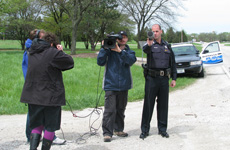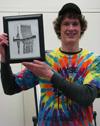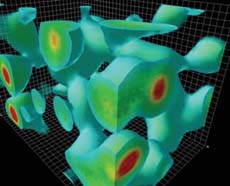|
Friday, May 9
3:30 p.m.
DIRECTOR'S COFFEE BREAK - 2nd Flr X-Over
4 p.m.
Joint Experimental-Theoretical Physics Seminar - One West
Speaker: A. de Gouvea, Northwestern University
Title: NuSOnG: Looking for Heavy and Light New Physics in High-Energy Neutrino Scattering
8 p.m.
Fermilab Lecture Series - Ramsey Auditorium
Tickets: $5
Speaker: Dr. Christian Butzke, Purdue University
Title: Wine Mythbusters: Elucidating the Science of Wine
Monday, May 12
2:30 p.m.
Particle Astrophysics Seminar - Curia II
Speaker: L. McAllister, Cornell University
Title: Primordial Tensor Perturbations in String Inflation?
3:30 p.m.
DIRECTOR'S COFFEE BREAK - 2nd Flr X-Over
4 p.m.
All Experimenters' Meeting - Curia II
Special Topic: Tevatron Orbit Stabilization
Click here for NALCAL,
a weekly calendar with links to additional information. |
Friday, May 9
- Italian vegetable soup
- Portabello mushroom melt
- Southern fried chicken
- Mediterranean baked tilapia
- Eggplant parmesan panini
- Assorted slice pizza
- Assorted sub sandwich
Wilson Hall Cafe Menu |
|
Wednesday, May 14
Lunch
- Stuffed filet of sole
- Lemon grass rice
- Spring vegetables
- Rhubarb & apple turnover
Thursday, May 15
Dinner
- Mushroom duxelle in a vol-au-vent
- Halibut w/Veracruz sauce
- Jasmine rice
- Chocolate raspberry cake
Chez Leon Menu
Call x4598 to make your reservation. |
|
|
E-mail spammers use research topics for bait
 |
| Mark Leininger |
E-mail scams are exploiting scientific advances. The text below was used to spam Fermilab employees and users this week. The text originated from a legitimate message from a university research professor. Unknown to the researcher, spammers combined his text with an attachment that contains malware and sent the message to a large number of indivduals at Fermilab. Fortunately, no one opened the attachment since the research topic in this case (environmental engineering) was not related to high-energy physics.
If the topic of this message had been something related to the LHC or one of the Run II experiments, or anything relevant to high-energy or astrophysics, someone would likely have opened the attachment and ended up with an infected machine.
The circulated infected e-mail text read:
Dear all,
Attached find two ES+T papers I've done using Chinese input-output models. We (the group on the China paper) have two other papers under review on China IO as well, one on exports and climate and another on long-term determinants of growth in CO2 emissions (from 1980 to 2030). This can hopefully give you an idea of the capabilities of what we have right now. We're absolutely interested in furthering these models with better data.
Don't fall prey to spammers. You are the laboratory's most important line of defense. Please use your common sense, intuition and training to help detect these kinds of exploits. Remember that spammers can easily craft e-mail to appear as though it was sent by someone you know or from a list that you subscribe to.
In the case mentioned above, the spammers spoofed the researcher's e-mail address. The researcher received about 100 undeliverable error messages the first day of the scam, and more than a few complaints that he didn't deserve. If you reply to messages from senders you don't recognize, they will know your e-mail address is valid and you will likely receive more spam. If anything about the message doesn't seem right, don't click on links and don't open attachments.
Avoid reading e-mail with html and images displayed inline by default. These messages can cause an infection if the html code or the image contain malware. If you receive e-mail that contains html or images, you can turn on the option to display them after you are confident of the sender's identity.
If anything happens that causes you to believe your machine may have been infected, please contact your system administrator. If they are not readily available, call the Helpdesk at x2345 and report the incident so computer security members can check your machine.
If you receive spam, please don't report it as a computer security incident (unless you have some reason to believe it has infected your machine). You cannot stop spam, but you can use tools to help reduce the amount received. The laboratory has a spam-tagging utility based on open source software called SpamAssassin. You can find instructions on how to configure and use it with e-mail clients here. You can also "teach" SpamAssassin whether e-mail is or isn't spam.
-- Mark Leininger, computer security manager
|
Radar gun for science

On Wednesday and Thursday, a film crew working for National Geographic visited Fermilab to interview scientists and to film a demonstration that will help explain what "redshift" is. Pioneer Productions contacted the City of Batavia Police Department and recruited Detective Shawn Mazza (right) to come to Fermilab and to demonstrate the use of a radar gun. The device bounces electromagnetic waves off cars and records the resulting shift in wavelength to determine the speed of cars. In analogy, the measurement of wavelength shift-redshift-of light waves emitted by celestial objects reveals the speed at which these objects are moving away from Earth. The film, tentatively named "The Big Bang," focuses on the evolution of the early universe. It will air some time next year.
|
Inspired student donates Wilson Hall artwork
 |
| Tyler Banas, a 17-year-old senior from Burlington Central High School, poses with his drawing of Wilson Hall. Banas donated his drawing to Fermilab. It now hangs in the Office of Communication. |
When Tyler Banas needed to draw a piece of architecture for his art class, the 17-year-old Burlington Central High School student immediately knew what to draw.
While other students agonized over the assignment, Banas carefully sketched Wilson Hall. The building's cathedral style architecture attracted Banas when he first visited Fermilab a year ago.
"I like it because it is really open," he said of the building.
Banas used a micro-pen to make the drawing, which took him 20 hours. A few months ago, he donated his drawing to Fermilab. It now hangs in the Office of Communication.
A lively teen with unruly hair and an easy smile, Banas fell in love with Fermilab when he came to the laboratory in the spring of 2007. He was part of the laboratory's Saturday Morning Physics program, where scientists teach students the basic concepts and experimental techniques of particle physics.
"Fermilab is the best kept secret. It has a different culture," Banas said.
Next year the science lover plans to attend Grinnell College, a small liberal arts college in Iowa, where he will major in physics, neuroscience or philosophy.
"I love the basic questions, such as why we are here," he said.
-- Rhianna Wisniewski
|
|
|
Testing the limits of the Standard Model

This frame is from an animation illustrating the typical four-dimensional structure of gluon-field configurations used by Sugar and his research group.
Image courtesy of Derek Leinweber, CSSM, University of Adelaide.
Questions about the Standard Model of physics have stymied scientists for decades, but now, thanks to supercomputing grid technology, Robert Sugar believes we'll have answers in just five to ten years.
Sugar, a professor of physics at the University of California, U.S., is a TeraGrid user and member of the MILC Collaboration, one of the largest users of open-science computing in the world. MILC first turned to computers for their calculations in the 1980s, believing only supercomputers could solve their intractable problems.
"There was a long period where people were developing the tools and algorithms, but not producing results that were accurate enough to have an impact on experiments," Sugar recalls.
"But that's no longer true," he continues. "Over the last five years, our calculations have become more and more accurate. We're beginning to do calculations that really have an impact on experiments."
Read more
- Aaron Dubrow, Texas Advanced Computing Center
|
Nobel laureates petition Bush over funding shortfall
From Physics World, May 8, 2008
A group of 20 Nobel-prize-winning physicists have written to US President George Bush, asking him to work with Congress to find at least $510m in "emergency supplemental funding" for the agencies that pay for much of the nation's physics research. The laureates sent the letter in response to a similarly-sized shortfall in the amount of money granted by Congress for scientific research in this financial year compared to what Bush had first proposed.
"[The 2008 budget] sends a terrible message to the next generation of scientists," the laureates complain in their letter. "Instead of providing incentives for budding scientists, the funding plan provides discouragement". The letter's signatories include laser pioneer Charles Townes, particle theorist Frank Wilczek and 2006 winners, the cosmologists George Smoot and John Mather.
The funding situation in the US been difficult this year because the budget for the 2008 fiscal year - which began in October 2007 - was only agreed upon in December 2008, after 11 months of wrangling between the President and Congress. This delay was bad news for those researchers and institutes that had already started spending their 2008 money, only to find that their funding had been cut back or even curtailed.
Read more
|
|
Fermilab pool won't open this summer
As a cost-cutting measure, Fermilab managers have decided not to operate the laboratory's swimming pool this year. The pool in the Fermilab Village normally opens for the season on Memorial Day. "With the budget cuts we have experienced in FY2008, we have to keep our focus on doing the physics," said Chief Operating Officer Bruce Chrisman.
|
|
Have a safe day!
Users' meeting June 4, 5
Fermilab will host the annual Users' meeting on Wednesday, June 4, and Thursday, June 5. For more information or to register, visit the Users' Meeting Web site.
Barnstormers meeting May 14
The Fermilab Barnstormers will conduct their monthly meeting on Wednesday, May 14, at 5:30 p.m.
at the Frelo Flying Field. In bad weather, the meeting will take place at the Users' center.
Any employees or users interested in model airplanes are welcome, and perhaps will even get some dual stick time with an instructor.
Linear Collider School accepts applications through May 15
The Third International Accelerator School for Linear Colliders will accept applications through May 15. Fermilab will host the school Oct. 19-29 at the Oak Brook Hills Marriott Hotel in Oak Brook. Graduate students, postdoctoral fellows, junior researchers and physicists considering a career change from experimental to accelerator physics may apply. The school will focus on TeV-scale linear colliders including the International Linear Collider and the Compact Linear Collider (CLIC). Visit the school Web site to apply or for more information.
Women can provide feedback on work environment at May 14, 28 luncheons
Calling all female staff, users and student and senior scientists! Fermilab Deputy Director Young-Kee Kim would like to hear about your work environment at Fermilab. Please join her for a lunchtime meeting from noon-1 p.m. on May 14 or 28. The meetings will take place in the small dining room in the southwest corner of the atrium in Wilson Hall. Please bring your lunch. To arrange a private meeting with Young-Kee Kim, please contact Marilyn Smith via e-mail.
Folk Club barn dance Sunday
The Fermilab Folk Club will host a barn dance on Sunday, May 11, at 6:30 p.m. with music by the Cosmic Otters and calling by Paul Watkins. More information
Interaction Management course
Through practice and feedback for supervisors and managers, this course will teach the essential skills and discussion guidelines necessary for effective coaching. Learn more and enroll
Introduction to LabVIEW
Learn how to build and custom test, measurement and control applications from scratch, using intuitive, measurement-specific graphical programming. Learn more and enroll
Classifieds
Find new classified ads on Fermilab Today.
Additional Activities
|
|